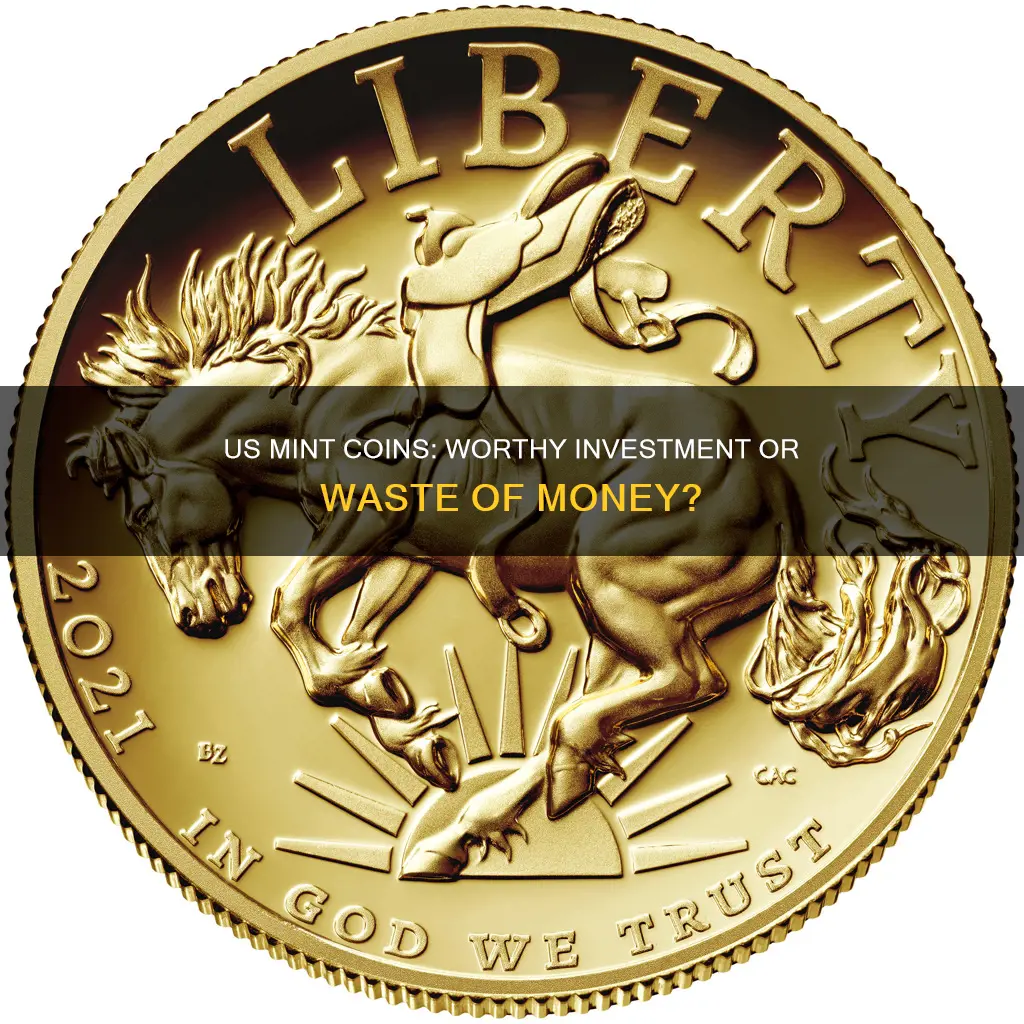
US Mint coins have been minted since 1792, providing a long history of production that has resulted in a wide range of coins with different values and investment potential. The value of a coin depends on several factors, including its rarity, demand, historical significance, and metal content. While gold and silver contribute to a coin's worth, collector interest can significantly increase its market price beyond its face value or metal price. The US Mint produces circulating, bullion, and numismatic (collector) coins, with bullion and numismatic coins being the most popular choices for investment purposes. Bullion coins' value is linked to the weight of the precious metal they contain, while numismatic coins have an intangible value based on their condition, rarity, and precious metal content.
| Characteristics | Values |
|---|---|
| Rarity | Rare coins are more likely to be valuable. |
| Demand | Collectors' interest can amplify a coin's market price. |
| Historical Significance | Coins with historical significance are more desirable. |
| Metal Content | Gold and silver coins have an intrinsic worth. |
| Economic Trends | Economic instability can increase the value of rare coins. |
| Grading | The less wear and tear, the higher the value of the coin. |
| Resale Value | Coins with higher resale value are better investments. |
What You'll Learn

US Mint coins: historical performance and outlook
The US Mint has been producing coins since 1792, providing a long history to assess the performance of its coins as an investment. The first rule of investing in coins is that they should be rare, and this rarity, coupled with historical allure, is what gives them value.
US Mint coins have a strong historical performance, with some rare coins increasing in value over time. For example, a 1907 Double-Eagle is highly prized by collectors due to its scarcity, and a 1933 Double Eagle gold coin sold at Sotheby's for $18.9 million. The US Mint's reputation and the historical significance of its coins influence their value.
The demand for US Mint coins has also been high throughout history, with intense demand leading to the expansion of minting operations across gold-rich regions like Charlotte and Dahlonega, and to the opening of a branch in San Francisco during the Gold Rush.
The performance of US Mint coins as an investment is subjective and depends on various factors, including rarity, demand, historical significance, and metal content. The best US Mint coins to purchase have historical and aesthetic value, with less wear and tear, and high grading scores.
US Mint bullion coins are a good investment option due to their high value. The American Gold Eagle coin, for example, is globally renowned. The US Mint's gold and silver coins are also attractive investments due to their reliable purity levels.
In terms of outlook, US Mint coins are expected to continue to be a valuable investment, with their reputation, historical significance, and aesthetic appeal making them desirable to collectors. The US Mint's commemorative coins, in particular, are expected to increase in value over time, with their resale value potentially transcending their metal content.
However, it is important to note that not all US Mint coins are equal in terms of investment appeal, and some may not offer equivalent resale value. It is crucial for investors to research and understand the market trends governing both the intrinsic metallic values and any additional historic or rare coin premiums before purchasing.
Small Bitcoin Investment: Worth the Risk?
You may want to see also

Factors influencing investment potential
When considering the investment potential of US Mint coins, several factors come into play. Here are some key aspects to keep in mind:
- Rarity and Limited Supply: The law of supply and demand applies to the value of coins. The rarer a coin is, the higher its potential value. US Mint coins with limited supply or unique features are often more desirable to collectors and investors.
- Historical Significance: US Mint coins with historical significance or connections to specific historical events or locations can be more valuable. For example, coins commemorating significant moments in US history or those with iconic designs like the Eagle design can be more desirable.
- Metal Content: The precious metal content of a coin contributes to its intrinsic worth. Gold, silver, and platinum US Mint coins are sought-after options. However, the metal content alone does not dictate the value of a coin.
- Collector Interest and Sentiment: Collector interest can significantly amplify the market price of a coin beyond its face value or metal value. The desirability of US Mint coins can be influenced by collector sentiment and the popularity of coin collecting as a hobby or investment strategy.
- Economic Trends: Economic trends and market conditions can impact the value of US Mint coins. In times of economic instability or high inflation, investors may turn to tangible assets like rare coins, driving up their value.
- Grading and Preservation: The condition and preservation quality of a coin are crucial factors in its investment potential. Grading factors such as surface preservation, strike quality, errors, and luster are considered when assessing the value of a coin. Coins with higher grades, indicating less wear and tear, tend to be more valuable.
- Reputation of the Mint: The reputation and long-term success of a mint can influence the value of its coins. US Mint, being a well-established and respected institution, commands higher premiums for its coins due to its trusted reputation.
- Aesthetics: The visual appeal of a coin can impact its investment potential. Some US Mint coins, like the Gold Eagle and Gold Buffalo, are sought after for their aesthetic design, making them more desirable to collectors and investors.
- Commemorative and Limited Edition Coins: Commemorative coins issued to mark specific events or occasions can have higher investment potential due to their limited mintage and historical significance. However, it is important to note that limited edition bullion may not always offer equivalent resale value, so buyers should carefully consider their investment goals.
- Geo-economic Shifts: Historical patterns show that geo-economic shifts, such as the Gold Rush, have influenced the expansion of mint branches and the production of certain coins. These shifts can impact the scarcity of specific coin issues, affecting their collectability and investment potential.
These factors, among others, can influence the investment potential of US Mint coins. It is important for investors to carefully research and consider these aspects before making any investment decisions.
Bitcoin: An Investment or a Gamble?
You may want to see also

Numismatic investments vs bullion
Bullion coins are gold and silver coins acquired for their precious metal content and are often available for a lower price. They are purchased for investment, as an inflation hedge, or for survival. Their weight is expressed as an even amount, such as 1-ounce, 1/2-ounce, or grams (for gold and silver bars). Examples of bullion coins include Canadian Gold Maples, South African Krugerrands, and 90% Junk Silver (pre-1965 half-dollars, quarters, dimes, etc.).
On the other hand, numismatic coins are considered rare and collectible. They are valued primarily for their rarity and not their metal content. Numismatic coins are generally worth more than their metal content and are purchased mainly by collectors. Examples include Pre-1933 $20, $10 Eagle coins and Peace Silver Dollars.
When deciding between the two, consider your primary objectives. If you are interested in the historical or collectible aspect of coins, numismatic coins might be a better choice. However, if you are looking to invest for your future or hedge against inflation, bullion coins may be more suitable.
It is important to note that numismatic coins carry a larger risk and often have a huge premium, which is influenced by factors such as demand, auctions, and timing. In contrast, bullion coins have a more stable value based on their gold or silver content, and they attract a large and active market worldwide, making them easier to sell.
Additionally, consider the investment horizon. Numismatic coins typically require a long-term investment horizon of at least ten years to realize their potential value increase. In contrast, bullion coins can be sold at any time and are more liquid.
In terms of safety, bullion coins are a safer choice as they have a timeless value that is less susceptible to external factors. Numismatic coins, on the other hand, have a value that can change over time and are more sensitive to market conditions.
Finally, when investing in bullion coins, focus on widely-circulated coins and consider buying in bulk to take advantage of economies of scale. For numismatic coins, rarity and historical value are key factors that influence their price.
Bitcoin or Ether: Which Crypto is the Better Investment?
You may want to see also

Grading systems for US Mint coins
In the early days of coin collecting, dealers had different grading systems based on their individual experiences, observations, and opinions, with very little standardization. However, in the 1970s, the American Numismatic Association (ANA) published the "Official A.N.A. Grading Standards for United States Coins," which established a universal set of grading standards.
The numerical grades assigned to coins range from MS-70 (perfect) to MS-60 (uncirculated but may be poorly struck with many heavy marks or hairlines). The MS-70 grade indicates a flawless coin with a sharp strike, original luster of the highest quality, and no contact marks visible under magnification. On the other hand, an MS-60 grade indicates an uncirculated coin with no wear but may have a dull or washed-out mint luster and many large detracting contact marks.
It is recommended that anyone considering investing in rare coins familiarize themselves with the Official A.N.A. Grading System. This system includes both Uncirculated Grades (Mint State) and Circulated Grades, with detailed descriptions and illustrations of typical coins in their respective states of wear.
Additionally, the Sheldon Scale, developed by renowned numismatist Dr. William Sheldon in 1948, assigns grades from "1" to "70" to coins, with the basis that a "70" would be worth 70 times as much as a "1." This scale was later adopted by PCGS (Professional Coin Grading Service) when they introduced third-party grading in 1986.
When investing in US Mint coins, it is crucial to consider factors beyond just rarity. Coin grading factors such as surface preservation, luster, strike quality, and errors can significantly impact a coin's value. Therefore, investors should prioritize coins with less wear and tear, as they tend to fetch higher prices among collectors and investors.
Bitcoin: Exploring Alternative Investment Opportunities
You may want to see also

Storing and protecting US Mint coins
If you're a coin collector, it's important to know how to store your coins properly to keep them safe and maintain their value. Here are some tips for storing and protecting your US Mint coins:
- Handling: Always handle coins with care. Hold them by their edges between your thumb and forefinger, and wear soft cotton gloves to protect the coin's surface from fingerprints and natural oils on your skin, which can be corrosive. Avoid polishing or cleaning coins as it can reduce their value. If necessary, use mild soap and water to clean a coin, then pat it dry with a soft towel.
- Storage conditions: Keep coins in a cool, dry place, avoiding sharp changes in temperature and moisture, which can cause discolouration and devaluation. Store them in a safe location, away from direct sunlight, extreme heat or cold, and pollutants such as cooking fumes.
- Storage containers: Use original holders and cases for modern coin sets and coins. Individual coins are typically packaged in capsules fitted into folders or boxes. Other storage options include cardboard or plastic holders, plastic tubes or capsules, sleeves, envelopes, and hard plastic holders for high-value coins.
- Protection from atmospheric conditions: Protect coins from humidity, as it can cause chemical reactions in metals like silver and copper. Avoid exposure to chlorine, as it can induce corrosion and blemishes. Use silica gel packets to absorb water vapour and control humidity levels, especially in sealed containers.
- Display and organisation: Consider using albums, folders, or holders designed for coin collections. These can provide a practical means of storage and organisation, with spaces to record relevant information about each coin. Display cases can also be used to showcase your collection while keeping the coins safe.
- Insurance and security: Ensure your coin collection is insured, especially if stored at home. Consider storing extremely valuable coins in a safe deposit box at a bank or a home safe.
- Reference and research: Familiarise yourself with coin reference books and resources to learn about dates, mint marks, varieties, grading guidelines, and prices. This knowledge can help you better protect and evaluate your collection.
Calculating Bitcoin Investments: What Could Have Been?
You may want to see also







